Prolog Data Structures
Terms
In Prolog, all data are represented by Prolog terms.
| Video: |
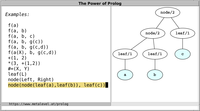
|
Each term is either a variable, an atomic term or
a compound term:
- variables start with an uppercase letter or with an
underscore (_). A single underscore denotes
an anonymous variable and can be read as
"any term". For example, X, Y, _爱 and Prolog are variables.
- atomic terms are:
- atoms, such as x, test
and 'quotes and space'
- integers, such as 42
- floating point numbers
- depending on the Prolog system, there are also
other kinds of atomic terms, such as complex numbers
and rational numbers.
- compound terms are defined inductively as
follows: If T1, T2,
..., TN are
terms, then F(T1, T2,
..., TN) is also a term, where F is
called a functor name and adheres to the same
syntax rules as atoms. F/N is called
the principal functor of the compound term,
and N is called the arity.
Examples: f(a), g(f(X)) and +(a,
f(X)).
All data can be represented in this way. Terms come into existence
by simply writing them down.
A term is called ground if it contains no variables. A
compound term is called partially instantiated if
one of its subterms is a variable.
Prolog is dynamically typed and allows us great freedom for
representing data. For example, we could represent natural
numbers as follows:
- we could use the atom zero to represent 0
- we could use the compound term s(X) to
represent the successor of X.
In this representation, the term s(s(s(zero))) represents
the number 3. Such a representation is of course highly
impractical due to its enormous size for large numbers. For
this reason, Prolog provides integer
arithmetic with a much more efficient number representation.
Prolog terms naturally correspond
to trees. There is a
standard order on terms.
You can define custom prefix-, infix- and postfix operators
that let you write terms in different ways.
| Video: |

|
Several standard
operators are predefined. For example, you can write a+b
and X=Y instead of +(a,b) and =(X,Y),
respectively.
Lists
Prolog lists are a special case of terms.
| Video: |
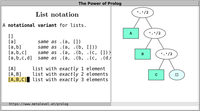
|
Lists are defined inductively:
- the atom [] is a list, denoting the empty list
- if Ls is a list, then the term '.'(L,
Ls) is also a list.
There is a special syntax for denoting lists conveniently in Prolog:
- The list '.'(a, '.'(b, '.'(c, []))) can also be
written as [a,b,c].
- The term '.'(L, Ls) can also be written as [L|Ls].
These notations can be combined in any way. For example, the term
[a,b|Ls] is a list iff Ls is a list.
Lists naturally represent collections of elements and arise
in almost all Prolog programs. When choosing between lists
and any other way to represent collections of elements, ask
yourself the following questions:
- Can there be arbitrarily many elements?
- Can there be zero elements?
- Is the order of elements significant?
- Are the elements of the same kind?
If your answer is "yes" to most of these questions, lists are
often a good fit.
In contrast, consider for example the case where each collection
comprises exactly three elements. You can use lists of the
form [A,B,C] to represent such collections, and thus
benefit from meta-predicates that
reason over lists. On the other hand, using compound terms of
the form f(A,B,C) is more memory efficient: This is
because the list [A,B,C] is the compound
term '.'(A,'.'(B,'.'(C,[]))) and thus takes
roughly twice the space of the term f(A,B,C)
in memory.
DCG notation is frequently used for
describing lists.
Pairs
Pairs are terms with principal functor (-)/2. For
example, the term -(A, B) denotes the pair of
elements A and B. In Prolog, (-)/2 is
defined as an infix operator. Therefore, the term can be
written equivalently as A-B.
| Video: |
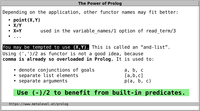
|
The standard
predicate keysort/2 is an
example of a predicate that reasons about pairs. They are
called Key-Value pairs because the first argument of each
pair is used as the key for sorting. Many Prolog systems
provide additional predicates for reasoning about pairs, and they
often adopt this terminology from keysort/2. Common
examples of such predicates are
pairs_keys_values/3 and pairs_keys/2 to relate a
list of pairs to their respective keys and values.
Association lists
In many Prolog systems, association lists are available to
allow faster than linear access to a collection of elements. These
association lists are typically based on balanced trees
like AVL trees.
There is a public domain library called library(assoc)
that ships with many Prolog systems and provides operations for
inserting, fetching and changing elements of a collection.
Here is one way to represent an AVL tree in Prolog:
- the empty tree is represented by the
atom t.
- an inner node is represented as
a compound term of the form t(Key, Value,
Balance, Left, Right) where:
- Key and Value represent
the association of Key
with Value.
- Balance is an atom that denotes a
balance criterion, such as a relation between the number of
children of the left and right subtrees. For example, we can
use the atoms <, = and > to
denote different states between the subtrees.
- Left and Right are AVL trees.
Every operation on AVL trees, such as adding or changing an
association, can be described as a relation between
different trees, one tree before the operation and
one after it. See Thinking
in States for more information.
AVL trees let us perform many important operations
in O(log(N)) time, where N is the number
of associations. This is acceptably efficient in many cases.
Strings?
Almost everything that needs to be said about strings has
been brilliantly said by Richard O'Keefe in
his Prolog
Library Proposal. In particular, strings
are wrong, and:
For almost any use case that involves some kind of processing,
the only sensible thing to do with string data is to turn it
into some kind of tree early. Prolog is brilliant with
trees.
In Prolog, a convenient and natural representation of strings is
to use lists of characters, which are
one-character atoms. If you set the Prolog
flag double_quotes to chars, then
double-quoted strings are automatically interpreted as lists of
characters. To enable this setting, add the following directive at
the start of your Prolog programs, or to your Prolog system's
configuration file:
:- set_prolog_flag(double_quotes, chars).
With this setting, we obtain for example:
?- "abc" = [a,b,c].
true.
Thus, working with strings is reduced to working
with lists, which can be easily handled
in Prolog and are amenable to built-in mechanisms such
as DCGs.
Treating strings as lists of characters has a long tradition in
Prolog systems, starting with the very first Prolog system,
Marseille Prolog. Some Prolog systems opted to represent
strings as lists of character codes, i.e., as lists
of integers instead of lists of atoms, and these
integers represent code points that depend on the used
encoding. This behaviour is available if you set the Prolog
flag double_quotes to codes. This is not
recommended though, because it renders answers much less readable
than using chars. Alternatively, you can also set the
flag to atom, which makes Prolog treat double-quoted
strings as
atoms. The main drawback of using the value atom
is that atoms preclude the use of DCGs and other predicates that
reason about lists and partial lists. In addition, since
atoms cannot be partially instantiated, your code will
become moded: This means that it can only be used in a
proper subset of all conceivable directions.
For these reasons, chars is the recommended setting, and
newer Prolog systems such as Scryer, Tau and Trealla Prolog
already use this value by default.
With a suitable implementation technique, Prolog systems can
represent lists of characters very efficiently, making them both
convenient and fast to work with.
| Video: |
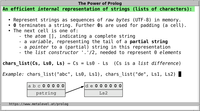
|
There is thus hope that more Prolog systems will
use chars as the default value in the future.
Arrays?
What about arrays? Is there any data structure in Prolog to
represent a collection of terms, allowing
for O(1) access to individual elements?
First of all, the concept of destructive modifications is
alien to logic programming. In Prolog, we
describe relations between entities, not destructive
effects. To express a change in a Prolog data structure, we define
a predicate that relates the state of the structure before
the change to a different structure after the change. For
this reason, pure modifications
often entail some copying of data and typically lead to at
least logarithmic overhead (for example, to copy a subtree of a
balanced tree).
That being said, we can access the arguments of a term
in O(1) with the built-in predicate arg/3. There
even is an impure predicate called setarg/3 which allows
destructive modifications to a term. Use it at your own peril: If
you use setarg/3, you can no longer reason about your
code in the way you expect from pure relations. If you really need
efficient destructive modifications of terms, it is better to
use attributed variables.
Type tests
There are predicates to test for specific types
of terms.
Unfortunately, the standard predicates for type testing
(atom/1, integer/1, compound/1 etc.)
are logically flawed because they are not monotonic: If you
use these predicates, then generalizing a query may lead
to fewer solutions,
preventing declarative debugging
based on logical properties. For example, atom/1 fails
for the most general query, even though it succeeds for
more specific queries:
?- atom(X).
false.
?- X = a, atom(X).
X = a.
Therefore, new families of predicates for type testing are now
becoming available. They implement type tests with desirable
logical properties:
- the ..._si/1 family of predicates which are like
the standard predicates if the arguments
are sufficiently instantiated
- must_be/2, used for input arguments
- can_be/2, used for output arguments and general arguments.
| Video: |
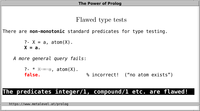
|
The predicates must_be/2 and can_be/2 are
especially useful for Prolog library
authors. The ..._si/1 family of type tests are useful in
normal Prolog programs, if you want to explicitly test for
specific types without raising type errors.
Importantly, all these predicates
raise instantiation errors
if the terms that are tested are not sufficiently instantianted to
allow a sound decision.
Clean vs. defaulty representations
When representing data with Prolog terms, ask yourself the following question:
Can I distinguish the kind of each component from
its principal functor?
If this holds, your representation is called clean. If
you cannot distinguish the elements by their principal
functor, your representation is called defaulty, a
wordplay combining "default" and "faulty". This is
because reasoning about your data will need a
"default case", which is applied if everything else
fails. In addition, such a representation prevents argument
indexing, and is considered
faulty due to this shortcoming. Always aim to avoid
defaulty representations! Aim for cleaner representations instead.
| Video: |
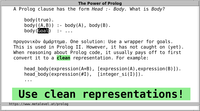
|
For example, suppose you represent a full binary tree in
Prolog. There are two kinds of elements in a full binary
tree:
- leaves, which are concrete elements of the tree
- nodes, which have two children that are again full
binary trees.
We can represent such trees with Prolog terms as follows:
- leaf(L) represents the leaf L
- node(Left, Right) represents a node and its
two children.
The above is a clean representation: It lets us distinguish
the kinds of elements by their principal functor. We can reason
about such trees in a way that keeps the code very general and
usable in all directions. Such a representation is also amenable
to argument indexing.
You can also recognize a clean representation if it lets you
describe the general structure of your data while retaining
enough flexibility to keep the concrete elements unspecified. For
example, in the case of full binary trees, we can represent the
general outline of all trees with exactly two leaves
as node(leaf(_),leaf(_)). If you had chosen
to omit the leaf/1 wrapper for representing
leaves, this would become node(_,_): a defaulty
representation that no longer represents precisely such
manifestations.
Sometimes, it will appear to you that there is no clean way out.
For instance, you may be faced with a representation
that requires you to distinguish different cases in an
impure and non-monotonic way, such as by testing
the instantiation of certain arguments
via var/1. In such cases, it is good practice to
restrict the impure parts of your program to small fragments, and
to convert any defaulty representation to a clean one
by introducing suitable wrappers that let you distinguish the
cases by pattern matching. This helps to ensure that you can
use your core predicates in multiple directions.
Term inspection
In Prolog, the most natural way to reason about terms is to
rely on unification. In addition, there are several
predicates that let you decompose and analyze terms. The most
important of these term inspection predicates
are functor/3, arg/3 and (=..)/2.
Here are examples that illustrate their usage:
?- functor(f(a,g(X)), Functor, Arity).
Functor = f, Arity = 2.
?- functor(Term, f, 2).
Term = f(_A,_B).
?- arg(2, f(a,g(X)), Arg).
Arg = g(X).
?- f(a,g(X)) =.. [Functor|Args].
Functor = f, Args = [a,g(X)].
?- Term =.. [f,a,g(X)].
Term = f(a,g(X)).
These predicates cannot be defined by a finite set of clauses, and
can therefore be considered higher-order
predicates. Do not get carried away with these predicates!
Everything that can be expressed by
pattern matching should be expressed by
pattern matching. For example, instead of functor(Term,
f, 2), you can simply write Term = f(_,_).
Every Prolog term has a canonical representation. If you
are ever unsure about the structure of a term,
use write_canonical/1 to obtain the canonical
representation. For example:
?- write_canonical(a+b="xyz").
=(+(a,b),'.'(x,'.'(y,'.'(z,[]))))
The canonical representation shows the structure of the term
in such a way that it can also be easily parsed by
external programs.
More about Prolog
Main page







